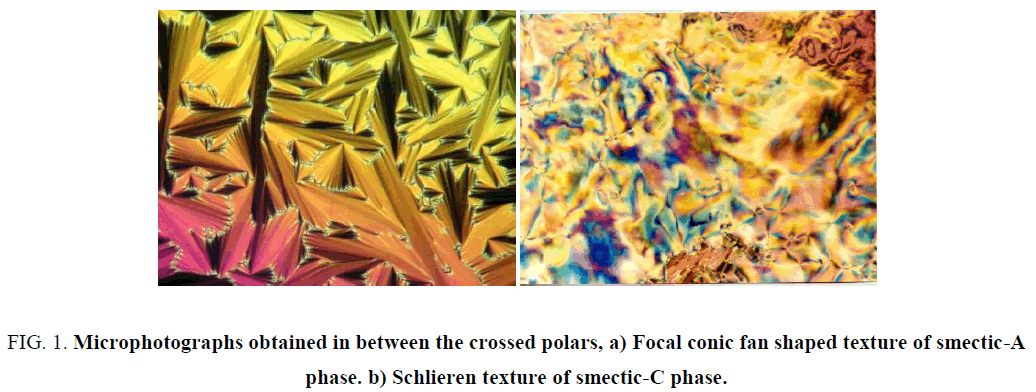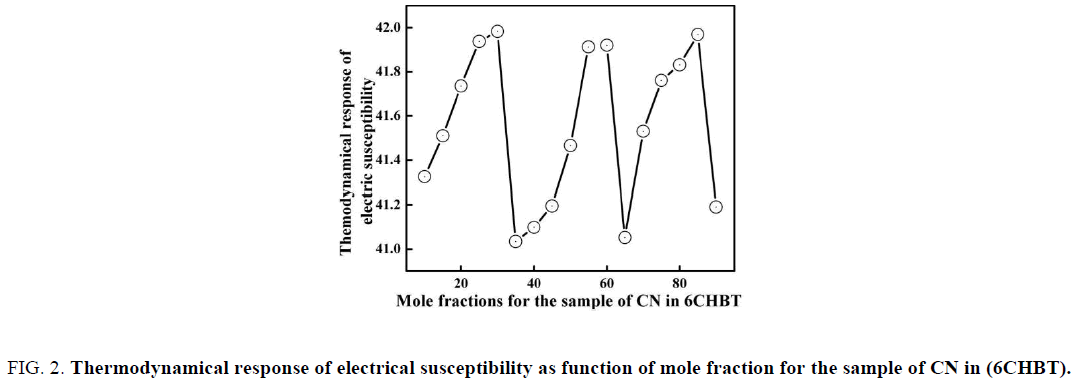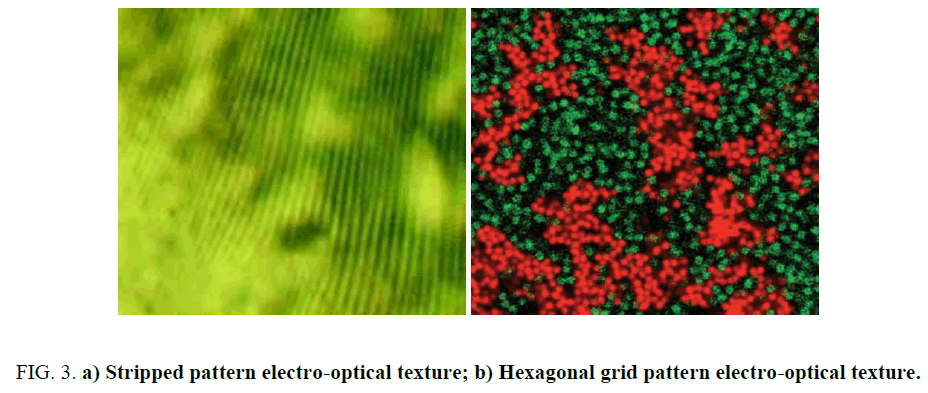Original Article
, Volume: 11( 6)Electro-Optical and Thermodynamic Studies on Induced Reentrant Smectic-A Phase in Binary Mixture of Liquid Crystalline Materials
- *Correspondence:
- Govindaiah TN, Research Centre, Post-Graduate Department of Physics, Government College (Autonomous), Mandya, Karnataka-571401, India, Tel: 08232220039; E-mail: tngovi.phy@gmail.com
Received: August 13, 2016; Accepted: October 22, 2016; Published: October 28, 2016
Citation: Govindaiah TN. Electro-Optical and Thermodynamic Studies on Induced Reentrant Smectic-A Phase in Binary Mixture of Liquid Crystalline Materials. Chem Technol Ind J. 2016;11(6):106.
Abstract
In the present work, our investigation is to study on the optical and electrical properties of binary mixture of cholesteryl nonanoate (CN) and 4-(trans-4’-hexylcyclohexyl) isothiocyanatobenzenes (6CHBT). Mixtures of these molecules exhibits cholesteric and induced reentrant smectic-A phases sequentially when the specimen cooled from its isotropic phase. These phases have been characterized by using microscopic technique. Thermodynamical response of optical anisotropy of electrical susceptibilities of reentrant smectic-A phase has been discussed. Temperature dependent electro-optical phase transition behaviors of the given molecules have also been discussed.
Keywords
Binary mixture; Optical textures; Optical anisotropy; Electro-Optical studies
Introduction
Liquid crystalline materials are the example of self-assembling media on a nano-scale level. Composed of anisotropic molecules, liquid crystalline compounds exhibit a great variability of structures, which are strongly susceptible to external fields as well as to interaction with the surfaces. For particular molecules assembled in specific architectures: a permanent dipole moment can appear thus forming structures with dipolar order, namely ferroelectric or anti-ferroelectric phases. Their physical properties have been intensively investigated and they have considered for a large variety of electro-optical applications. Recently, display based on anti-ferroelectric SmC* materials have been reported profiting from their higher threshold electric field for switching. A large potential application of these liquid crystalline materials is stimulated a great progress in the synthesis and research. The outstanding physical properties of ferroelectric (and possibly anti-ferroelectric) smectic liquid crystalline (SmC*) are attracting attention especially after the nematic liquid crystal materials have been developed to the limits of their performance [1-6].
In the present investigation, our aim is to study the binary compounds namely, cholesteryl nonanoate (CN) and 4-(trans-4’-hexylcyclohexyl) isothiocyanatobenzenes (6CHBT), which exhibits cholesteric, and induced smectic phases, respectively at different temperatures. These phases were observed using microscopic technique. Optical anisotropy and the effect of electro-optical phase transition behavior have been discussed.
Experimental Studies
Mixtures of different concentrations of CN in 6CHBT were prepared and were mixed thoroughly. These mixtures of different concentrations were kept in desiccators for a long time. The samples were subjected to several cycles of heating, stirring and centrifuging to ensure homogeneity. The phase transition temperatures of these concentrations were measured with the help of Leitz-polarizing microscope in conjunction with hot stage. The samples were sandwiched between the slide and cover slip and were sealed for microscopic observations. Refractive index has been measured using Abbe refractometer. A polarizer has been introduced in Abbe refractometer to block the extraordinary ray, which clears the contrast of the boundary line at view of refractometer and hence to calculate birefringence Δ n. Abbe refractometer temperature is controlled by circulating heated oil using JULABO F-25, refrigerated circulator. The temperature was measured by placing a thermocouple in close vicinity of the sample with an accuracy of 0.10°C. Electro-optical measurements were carried out by the usual experimental setup as described by Williams [7]. It consists of tin oxide coated transparent conducting glass plate and the sample sandwiched between these two glass plates. Teflon spacers having thickness of d=39 μm ± 1 μm were used and observations were made at 65°C using polarizing microscope in conjunction with a hot stage.
Optical Texture Studies
Molecular orientations of optical textures exhibited by the samples were observed and recorded using the Leitz-polarizing microscope in conjunction with hot stage. The specimen was taken in the form of thin film and sandwiched between the slide and cover glass. The concentrations from 10% to 90% of binary mixture of CN in (6CHBT) have been considered for the experimental studies. When the specimen of 40% of CN in (6CHBT) is cooled from its isotropic melt and hence it exhibits cholesteric, SmA, SmC, reentrant SmA and SmB phases sequentially. While the sample is cooled from its isotropic phase, the genesis of nucleation starts in the form of small bubbles growing radially, which are identified as spherulitic textures of cholesteric phase. On further cooling the specimen, the texture slowly transform to focal conic fan texture of SmA phase in which the molecules are arranged in layers and the texture is as shown in Figure 1a. On further cooling the specimen, the unstable SmA phase changes over to schlieren texture of SmC phase and it as shown in Figure 1b. Sequentially on cooling the specimen, SmC phase slowly changes over to reentrant SmA.
Figure 1: Microphotographs obtained in between the crossed polars, a) Focal conic fan shaped texture of smectic-A phase. b) Schlieren texture of smectic-C phase.
In our experimental studies, the different liquid crystalline phases have been identified on the basis of microscopic texture. These observations clearly indicate that the given mixture exhibits a very interesting reentrant smectic-A phase [8]. The lowest temperature mesophase of some certain compounds exhibits two or more mesophases of the same type, over different temperature ranges. Reentrant mesophases are most commonly observed when the molecules have strong longitudinal dipole moments. The sequences of reentrant mesophases have also been found in binary mixtures of non polar liquid crystalline compounds [9]. In the given mixture, some of middle concentrations of CN at lower temperatures did not show the molecular aggregates in preferred direction of alignment towards the crystalline phase, but it randomly oriented to form a reentrant smectic phase. On further cooling the specimen, reentrant smectic-A phase changes over to SmB phase, which remains up to room temperature and then it becomes a crystalline phase [10,11].
Themodynamical Response of Electrical Susceptibility
Studies on different mixtures of liquid crystalline materials are more important not only from the viewpoint of their technological applications but also from that of fundamental studies in the field of molecular interactions [12]. Thermodynamic studies are very important role to understand the phase stability, chemical structure and dynamics of liquid crystals [13,14]. Temperature dependent molecular orientations of liquid crystalline phases have been considered in many technological applications. The applied applications of these technologies are based on the properties of molecular structure and intermolecular interactions. The intermolecular forces such as Vander Waals interaction, hydrogen bonds, electron donor interactions and steric repulsive interactions are they individually or together may be responsible for increasing or decreasing the thermal stability of liquid crystalline phase [15].
Thermodynamical studies on liquid crystalline phase at different concentrations of binary mixtures of liquid crystalline materials are estimated using Boltzmann distribution laws. Draw a graph of variations of thermodynamical response of electrical susceptibility as a function of mole fraction for the sample of CN in (6CHBT) at constant temperature 65°C is presented in Figure 2. Here in this context, we have been observed three peaks, which clearly show the degree of micro-phase separations and hence they are one of the parameters to controlling a physical property of liquid crystalline materials [16]. In this context, the existence of electrical susceptibility can be varied either through chemical modification or through physical modification and hence they are depends on nature of additives molecules. From the figure, clearly we observed that, statistically how the electrical susceptibility is thermodynamically changes at different concentrations in order to show the thermal stability of molecules of the liquid crystalline phase. Here if at constant temperature, the given molecules are fractionally varies as increasing the concentrations of additive molecules.
Figure 2: Thermodynamical response of electrical susceptibility as function of mole fraction for the sample of CN in (6CHBT).
In this study, it is very interesting to observe a spin temperature. Due to this gradient temperature, on the surface area of the molecules of reentrant smectic-A phase, the degrees of freedom of molecules are thermodynamically varies with one mole fraction to the other. If an increasing the mole fractions for the sample of CN in (6CHBT); thermodynamical response of electrical susceptibilities of molecular orientations are increases with spin temperature, because the effective intermolecular interactions of anisotropic energy associated with the molecules of CN increases with the additive ones. The molecular ordering or the thermal phase stability of reentrant smectic-A phase at given constant temperature, the intermolecular interactions of anisotropic energy are responsible for the charges of carbon and the adjacent hydrogen molecules and which shows the correct electrostatic potentials are reproduced by different partial charge distributions. If increasing/decreasing the mole fractions for the sample CN in (6CHBT) and hence it shows small variation of electrostatic potentials and they around the molecule. In spite of these uncertainties, the full sets of partial charges are very useful, as it can provide a detailed insight into the molecular arrangement in reentrant smectic-A phase and which they reproduce the electrostatic potential.
Electro-Optical Studies
Electro-optical measurements are a very important tool in getting better idea on the phase behavior with electric field at constant temperature. In this experimental study, we have been considered the sample for the mixture of 40% CN in (6CHBT) at constant temperature 65°C. When the applied voltage increases, the molecular arrangements of liquid crystalline phase start to fluctuate and begin to grow; hence it deforms gradually the original position. Remarkably it has been observed that, if at constant temperature, the various aspects of low frequency effects on the given mixture show the different directions of molecular re-orientations exhibited a flow patterns formed, such as stripped pattern and chevron textures, the formations of zig-zag domains are characteristic of chevron textures, the forming time of these patterns depends on the applied electric field. If there we observed the significant differences in the electro-mechanical responses of these textures. The stripe of textures does not have a linear electromechanical effect at low fields, only at higher fields does the mechanical vibration have a component of the frequency of the field. This indicates that the spontaneous polarization has rotated and is no longer parallel to the electric fields. In contrast to the director re-orientations, the layer structure is unchanged by the application of the field. Sequentially we have to increase the applied voltage above 22.20 V, the observed pattern becomes dynamic scattering mode-like and it has been appearing like irregularity of molecular re-orientations of liquid crystalline phase. The new disordered regions are arises probably due to the molecules not being confirmed to the orientations in the X, Z plane. If the voltage is kept constant for some time, a completely stationary and regular two-dimensional hexagonal grid pattern is observed. The stripped pattern and hexagonal grid pattern textures are as shown in Figure 3a and 3b. The hexagonal grid pattern deforms gradually with increasing frequency and at some stage it becomes indistinguishable from the chevron texture. However, the hexagonal grid pattern is rather stationary and is formed in a short time at 250 Hz, 23 V. From the Figure 3a, it follows that, an extremely regular hexagonal grid pattern is formed when the external electric field is applied. One of the regions is that, the formation of hexagonal grid pattern is the electronic charge injected by the applying external electric field [17-19].
Figure 3: a) Stripped pattern electro-optical texture; b) Hexagonal grid pattern electro-optical texture.
Conclusion
Microscopic investigation of the binary mixture of CN in (6CHBT) shows existence of cholesteric, and induced smectic phases such as SmA, SmC, ReSmA and SmB phases for higher/lower concentrations of the given mixture. The drastic changes in optical anisotropic measurements values unambiguously correspond to different liquid crystalline phases, respectively at different concentrations and temperature. Thermodynamical response of electrical susceptibility have also been discussed to understand the degree of micro-phase separations, which is one of the parameters to controlling a physical property of molecular interactions of given molecules and show statistically how the electrical susceptibilities are thermodynamically changes at different concentrations in order to show the thermal stability, phase stability, chemical structure and molecular dynamics of the binary mixture of liquid crystalline phase. Under the applied electric field at constant temperature unambiguously corresponds to optical purity of liquid crystalline phases. The various aspects of frequency effects on given mixture show different directions of molecular re-orientations: which exhibit a flow patterns formations such as stripped pattern chevron textures and hexagonal grid pattern textures and hence these textures microscopically have been observed.
References
- Clark NA, Lagerwall ST. Submicrosecond bistable electro‐optic switching in liquid crystals. Appl Phys. 1983;36:899-901.
- Goodby JW. Ferroelectric Liquid Crystals. Principles, Properties and Applications. London: Gordon and Breach Science Publishers S.A., UK; 1991.
- Lueder E. Liquid Crystal Displays. 2nd ed, Chichester: John Wiley & Sons, UK; 2010.
- Yang D, Wu S. Fundamentals of Liquid Crystal Devices. Chichester: John Wiley & Sons, UK; 2006.
- Lagerwall ST. Ferroelectric and Antiferroelectric Liquid Crystals. Weinheim: John Wiley & Sons, Germany; 1999.
- Redl FX, Cho kKS, Murray CB, et al. Three-dimensional binary super lattices of magnetic nanocrystals and semiconductor quantum dots. Nature. 2003;423:968-71.
- Williams R. Liquid crystals in an electric field. Nature. 1963;199:273-4.
- Govindaiah TN, Sreepad HRJ. Phase transition and thermal characterization of induced smectic phases in a ternary mixture. J Mol Liq. 2015;202:75-8.
- Baron M. Polymer division commission on macromolecular nomenclature. Pure Appl Chem. 2007;79(10):1801-29.
- Gao B, Zhang L, Bai Q, et al. Smectic liquid crystals based on hexaazatriphenylene: potential organic n-type semiconductor. Chem. 2010;34:2735-837.
- Govindaiah TN, Sreepad HR, Sathyanarayana PM. Micellar nematic phase in a binary mixture of two nonmesogenic compounds. Mol Cryst Liq Cryst. 2012;552(1):24-32.
- Collings PJ, Hird M. Introduction to liquid crystals: Chemistry and physics. London: Taylor & Francis, UK; 1997.
- Soule ER, Rey AD. A good and computationally efficient polynomial approximation to the Maier–Saupe nematic free energy. Liq Cryst. 2011;38(2):201-5.
- Amoros JG, Szymczyk A, Velascko D. Thermo dynamic properties of a nematogen a computational approach. Chem Phys. 2009;11:4244.
- Lubensky TC. Critical properties of random-spin models from the ε expansion. Phy Rev. 1975;11(9):3573.
- Kercha YY. Physical Chemistry of Polyurethanes. Kyiv: Naukova Dumka, Ukraine; 1979.
- Helfrich W. Thermo-optical and electro-optical response of binary mixture of liquid crystalline mixture Mol. Cryst Liq Cryst. 1973;21:193.
- Krishnamurti D, Revannasiddaiah D. Optical anisotropy of the molecules of the homologs of thallium soaps. Mol Cryst Liq Cryst. 1983;94:317-25.
- Kai S, Yamaguchi K, Hirakawa K, et al. Phase diagram of dissipative structures in the nematic liquid crystal under a.c.-field. Appl Phys. 1975;14:1385.




